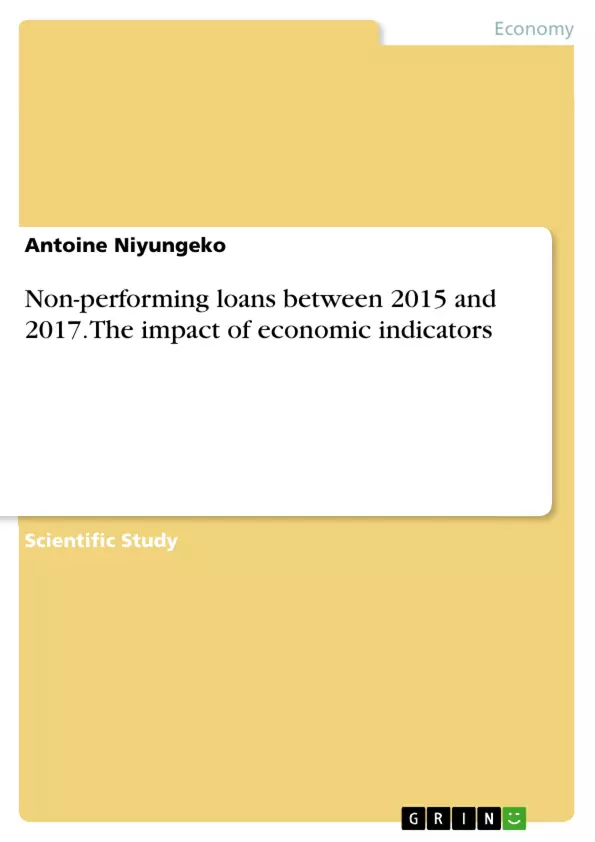This paper investigates the impact of economic indicators in their relationship to non-performing loans and the way the indicators change trough times using a cross-sectional analysis from the sample of 70, 69 and 63 world countries.
Using the robust regression approach, economic indicators were analysed to find their impact on non-performing loans for the period from 2015 to 2017. The results show that the economic indicators negatively relate to non-performing loans are population growth rate (PG), current balance account (CBA), claims on private sector (CPS) and domestic credit to private sector (DCPS).
Economic indicators have a positive impact on non-performing loans are gross domestic product growth (GDPG) and inflation. The findings also show that economic indicators affecting non-performing loans are changing. During the periods analysed, there is an increase in economic indicators affecting non-performing loans. They were only domestic credit to private sector, current balance account and claims on private sector in 2015. In 2016, another factor occurred in addition of those of 2015, inflation. In 2017, additional factors again occurred, population growth and gross domestic product growth.
Banks should take recovery measures to reduce non-performing loans. A better assessment of the repayment capacity of the future customers coupled with a permanent follow-up of the customer during the whole credit cycle should be enhanced. Further investigations are needed to understand the interactions, and the relationships between non-performing loans, and the different types of borrowers, namely; individuals, small and medium enterprises, and corporate borrowers for a better customer selection because an increase in domestic credit to private sector reduces non-performing loans. Banks should develop a credit risk assessment model combining internal and customer factors.
Inhaltsverzeichnis (Table of Contents)
- Abstract
- Introduction
- Literature Review
- Data and Methodology
- Empirical results
- References
Zielsetzung und Themenschwerpunkte (Objectives and Key Themes)
This paper aims to explore the relationship between economic indicators and non-performing loans, analyzing how these indicators change over time. The study utilizes a cross-sectional analysis of data from 70, 69, and 63 countries, spanning the period from 2015 to 2017.
- Identifying economic indicators that influence non-performing loan levels.
- Analyzing the impact of these indicators on non-performing loans.
- Exploring the evolution of economic indicators and their relationship with non-performing loans over time.
- Investigating the potential for mitigating non-performing loans through improved risk assessment and customer management.
- Analyzing the significance of domestic credit to private sector in reducing non-performing loans.
Zusammenfassung der Kapitel (Chapter Summaries)
- Introduction: This chapter introduces the study's objective of examining the impact of economic indicators on non-performing loans and their temporal shifts. It highlights the crucial role of banks in financing economic growth and the challenges posed by non-reimbursed loans. The chapter emphasizes the importance of understanding the relationship between economic factors and non-performing loans for informed decision-making by both bank managers and policymakers.
- Literature Review: This chapter provides a comprehensive overview of existing research on the relationship between economic indicators and non-performing loans. It examines previous studies that have explored this link and analyzes the various factors that have been identified as influencing loan performance. The chapter also discusses the methodological approaches used in previous studies, providing a foundation for the current research.
- Data and Methodology: This chapter describes the data sources and the methodological approach employed in the study. It outlines the data collection process, including the selection of countries and the time period covered. The chapter details the specific economic indicators examined and the statistical methods used for analysis, including robust regression techniques.
Schlüsselwörter (Keywords)
This study focuses on key economic indicators such as inflation, population growth, unemployment rate, interest rate, domestic credit to private sector, current balance account, bank capital asset ratio, foreign direct investment, and gross domestic product growth. The research also examines robust regression techniques and the impact of these indicators on non-performing loans.
- Arbeit zitieren
- Antoine Niyungeko (Autor:in), 2020, Non-performing loans between 2015 and 2017. The impact of economic indicators, München, GRIN Verlag, https://www.hausarbeiten.de/document/902029



